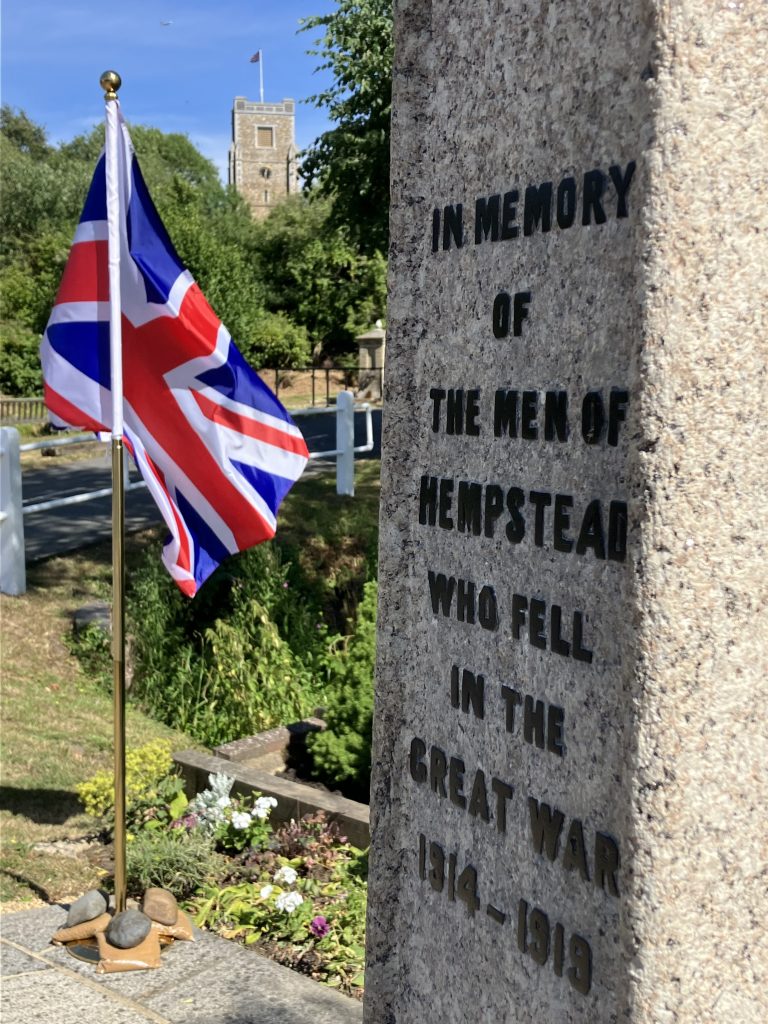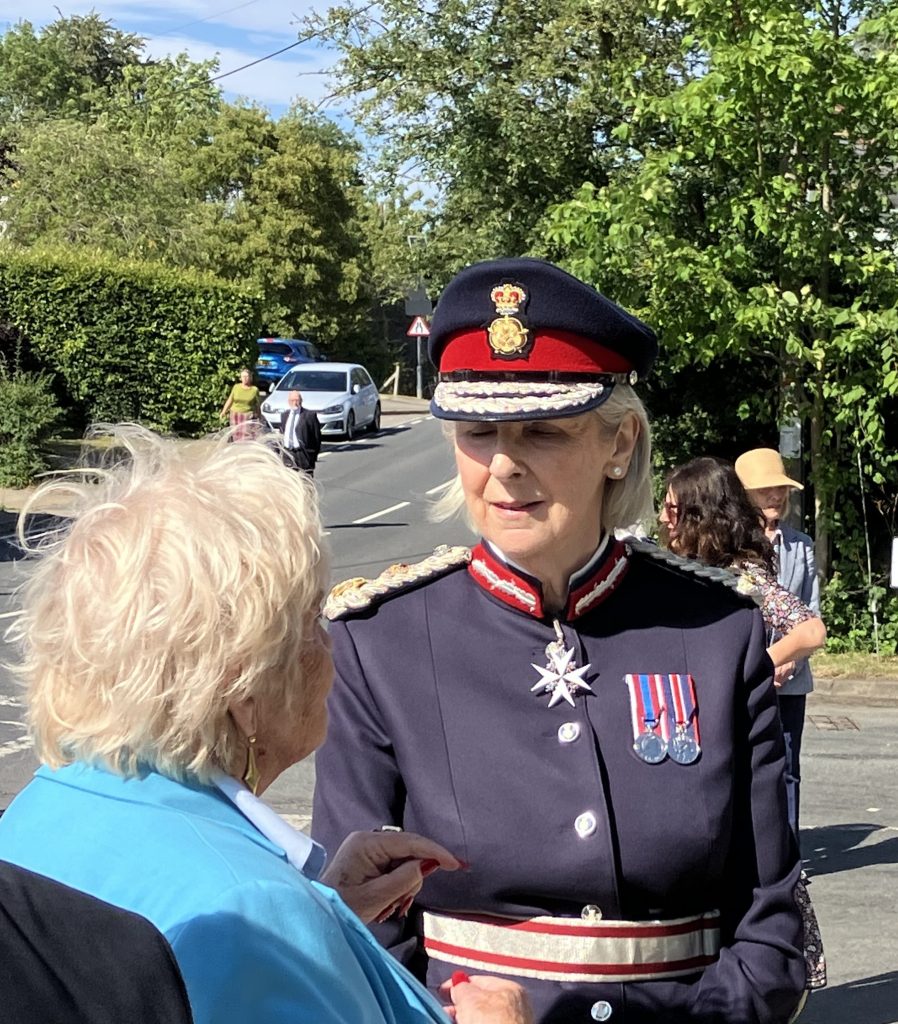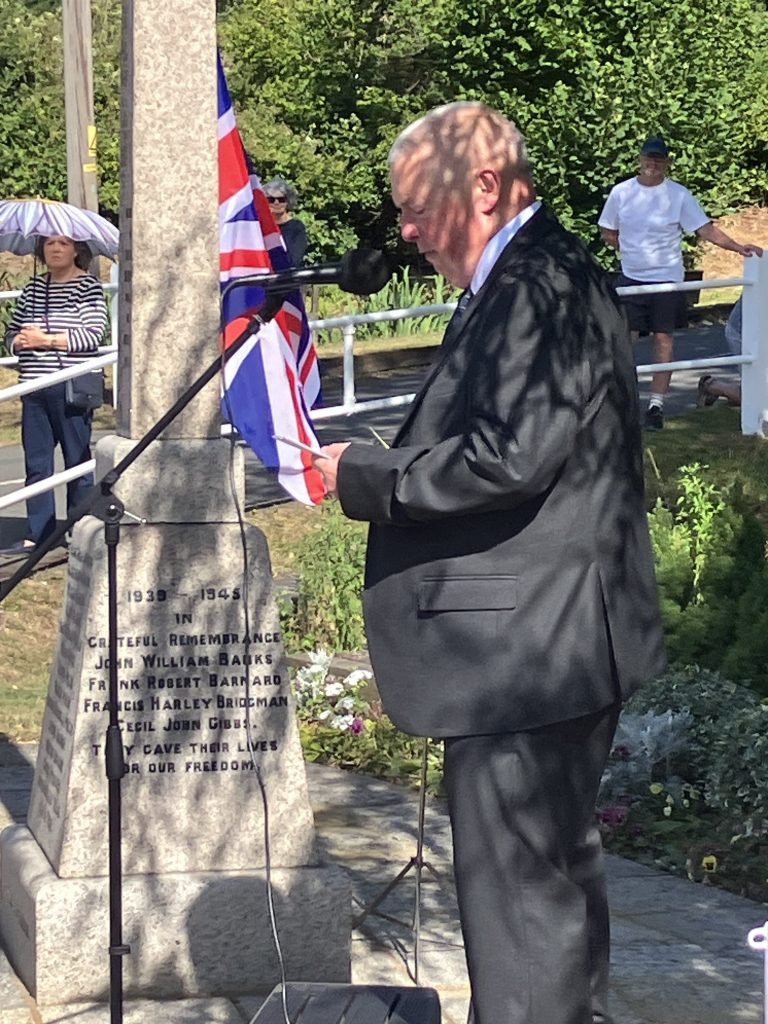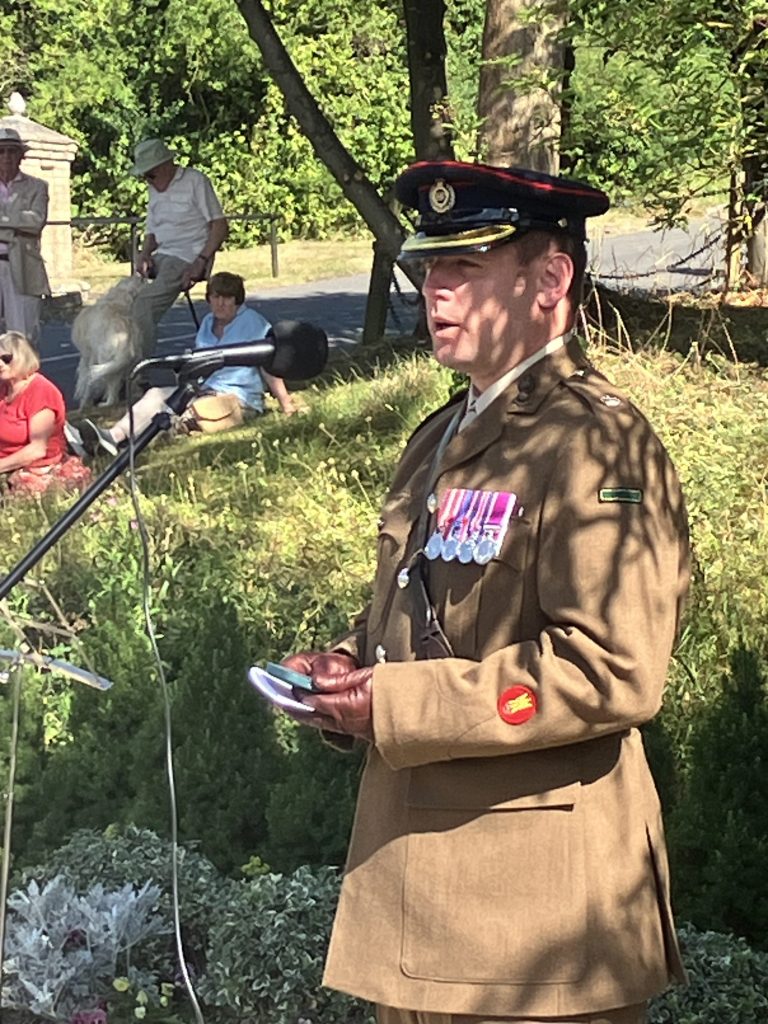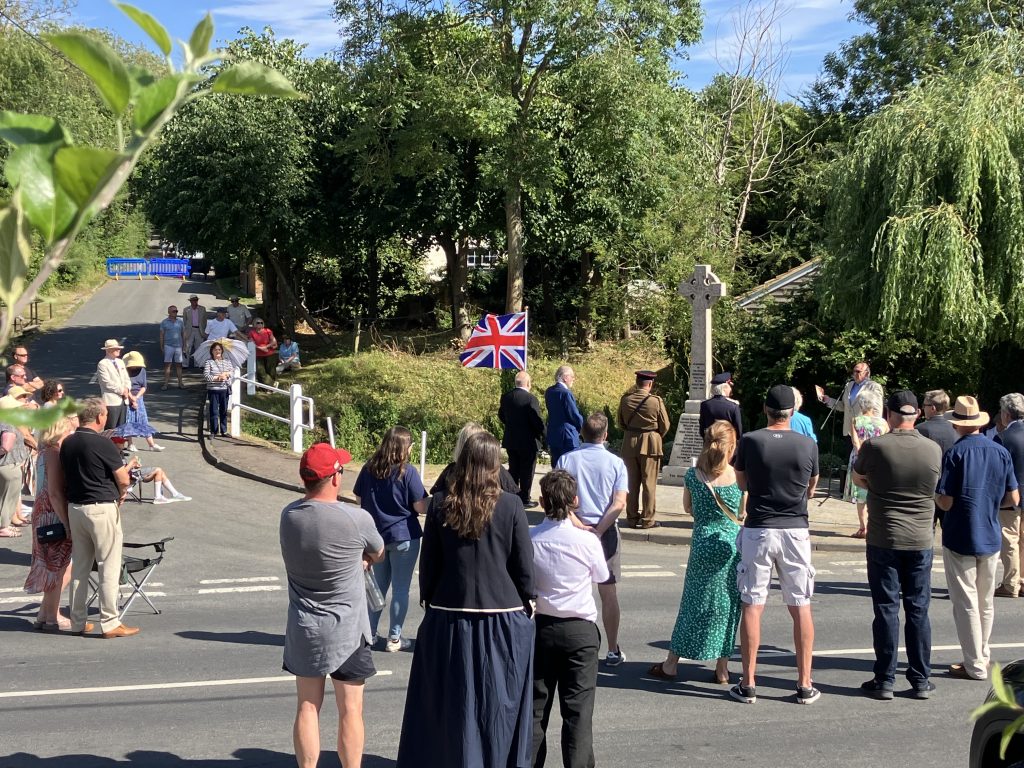
Exactly one hundred years after the memorial was first dedicated in the presence of Lt Gen Sir Francis Lloyd, the village marked the centenary with a ceremony on Friday 4 July 2025.
The ceremony, expertly stage managed by Diana Frost, was attended by the Lord-Lieutenant of Essex, Jennifer Tolhurst (representing His Majesty the King) and by Major Andrew Cadogan of the 35 Engineer Regiment (Explosive Ordnance Disposal & Search) based at Carver Barracks; Tina Knight, local entrepreneur and the liaison officer for Carver Barracks; Councillor Martin Foley of Essex CC; and Dr Mike Taylor, our District Councillor. With the High Street and Church Hill closed to traffic, about 60 residents also attended in the summer sunshine.
The ceremony was introduced by Parish Council chairman Nick Turkentine, followed by speeches from Ross Midgley and Major Cadogan. The text of Ross’s speech, recounting the stories of two of the men honoured on the memorial, is set out below. After the speeches, flowers were laid by the Lord-Lieutenant, Major Cadogan, the Parish Council and the Radwinter Cubs.
After the ceremony, tea and cake was provided in the beautifully decorated Village Hall, which also staged a marvellous exhibition of WW1 memorabilia, assembled by Tricia Ridgway from her father’s collection.
Ours is one of over 100,000 war memorials in the UK. It lists eighteen names, all of them men of Hempstead who died serving in one of the last century’s two world wars. For what we know about how these men lived and died, we must acknowledge the detailed work done by Hempstead’s history group at the time of the millennium celebrations; and the expansion, since that time, in the online availability of genealogical and military service records.
We must also acknowledge the efforts which the men’s friends, families and loved ones made at the time to ensure that their names would not be forgotten. Every letter, every grave marker, every notice in the in memoriam columns of the local press, has added – often in ways that the writers at the time could never have imagined – to their stories.
Each of the eighteen names represents a personal tragedy – not just for the families of those who lost their lives, but for the whole village. Remember that nearly all these men worked on local farms. They all knew one another: and as friends, as colleagues, as church or chapel-goers, as drinking companions, far better than as fellow soldiers. Remember that their families, their parents, their brothers and sisters, all knew one another as well. And remember too that, in those days, the sweethearts that they left behind were almost all Hempstead people.
So if, today, we remember Hempstead’s war dead, we must not forget all these other Hempstead people affected by their deaths. And, for everyone who died, many other Hempstead men and women fought alongside them, sustaining physical or mental scars or – for the so-called ‘lucky’ ones – nothing but an enduring sense of guilt, loss and grief.
And Hempstead’s is just one of 100,000 memorials.
In selecting two brief stories to tell today, I have not indulged in any grim ratings system to choose the most heroic or the most tragic death. They are all heroic and they are all tragic. My choice is based on the fact that they illustrate two contrasting aspects of the pity of war – on the one hand, its almost comic triviality and, on the other, its sheer bestiality.
George Foster was born in Hill Road in 1888. Like his father and his brother, he was a farm labourer from an early age. His next door neighbours were the Andrews family, who lost two boys in the fighting.
George was twenty-six when the war broke out, and was one of the first men from Hempstead to join up. Six weeks after he arrived in France, his mother received a postcard from Corporal Harry Purkiss – another Hempstead man and a family friend – saying that George had been wounded.
Shortly afterwards, poor Harry had to write again – this time, a letter. This is what he said.
“I went to make enquiries yesterday about [George], only to find when I got there that he had died of wounds shortly after being hit. I can’t tell you how sorry I feel for you, but I trust God will give you strength to bear the blow.
“It appears that he was hit twice; the first time was not serious, and while they were bandaging him, before they could shift him, he was hit again. I don’t know if I’m doing right in writing this to you, but I didn’t know what to do after sending you the postcard.”
Harry Purkiss’s own younger brother, Alfred, had arrived in France a week before George and had already been wounded in the chest. Harry himself returned to Hempstead after the war, married Florence Drane and went to work at Church Farm.
In the year that the First War broke out, a baby was born in Stone Cottages, opposite what is now Harvey Way. His parents, Herbert and Salome Gibbs, christened him Cecil. He would almost certainly have attended Hempstead School and he later grew up to be a local lorry driver.
Cecil Gibbs joined up on the outbreak of war in September 1939. Three years later, his battalion, the 1st Cambridgeshire, was sent to Singapore as part of the doomed attempt to defend the island against the advancing Japanese forces. 80,000 men were taken prisoner at the fall of Singapore. Cecil Gibbs was taken first to Changi POW Camp but later by rail through Malaya and into what was them Siam.
The journey took five days, with thirty-one men at a time packed into a metal truck in intense heat, with a bucket of rancid boiled rice to share each day. They all suffered from dysentery and dehydration. When they arrived at the clearing station, they were forced to march 100 miles on foot to Kinsaiyok Number 1 Jungle Camp. This was to be Cecil’s home for the rest of his life, as he worked to build the Burma Railway.
That life lasted eight months. He died of dysentery on 22 July 1943. His mother Salome was still living in Hempstead at the time.
There is more about these men – and the seventeen others named on the memorial – in my booklet At the Going Down of the Sun, which will be available in the village hall after this ceremony. I feel no qualms about promoting it, as every penny raised from its sale will go to the Royal British Legion’s Poppy Appeal.
And now I would like to close with a short poem that I think deserves to be better known. Its subject, Edward Thomas, was himself a poet and is best known for Adlestrop, his wonderful evocation of English summers and railways, which regularly features in lists of the country’s best loved poems.
Edward Thomas was killed at Arras in 1917, like two of the men on our memorial (Frank Andrews and Arthur Turner). His friend, the Welsh writer WH Davies, wrote this tribute to him, entitled Killed in Action (Edward Thomas).
Happy the man whose home is still
In Nature’s green and peaceful ways;
To wake and hear the birds so loud,
That scream for joy to see the sun
Is shouldering past a sullen cloud.And we have known those days, when we
Would wait to hear the cuckoo first;
When you and I, with thoughtful mind,
Would help a bird to hide her nest,
For fear of other hands less kind.But thou, my friend, art lying dead:
War, with its hell-born childishness,
Has claimed thy life, with many more:
The man that loved this England well,
And never left it once before.Thank you.
